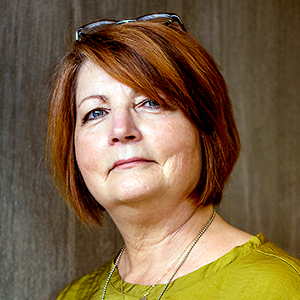
Story by Aaron Weintraub
The UO School of Journalism and Communication’s Carolyn S. Chambers Distinguished Professor of Advertising Deborah Morrison has been trying to start a new movement in advertising.
As you might expect, it’s a lot of work — but totally worth it. Over the past few years, she’s been developing not one, but two communications projects: EPOCH: A New Era for Ideas & Idea People Built with Courage and Conscience, and Science and Memory. Both projects aim to connect creative minds from different specialties within the SOJC to help bring about “a new chapter in the advertising industry, where those kinds of wonderful skills can be used to find solutions to climate change issues.”
Morrison’s efforts haven’t gone unnoticed. “Through a couple of columns I’ve written, through some places I’ve been to and spoken at … I’ve gathered sort of a following,” she said.
Morrison presented her ideas to about 25 people at the South By Southwest Festival in Austin in March 2016. There, she met Swedish communications specialist Klas Rabe. After they bonded over creative thinking’s role in climate change, “he went back home and he said to his bosses, ‘Why don’t we put together something about the power of these creative issues?’”
A common cause
The result was The Creative Powers for Europe Convention, held in November in Malmo, Sweden. Rabe did not forget to invite Morrison, who spoke on a diverse panel alongside professionals from a wide range of professions who hailed not only from Sweden and surrounding countries like Denmark, but also as far afield as Japan, Brazil and Israel.
All of the panelists, however, were there for the same reason — to share new solutions to climate change issues.
“The artists came in and said, ‘Art will have to take a strong place in doing things,’” Morrison said. “Then the bureaucrats came in and said, ‘Wait a minute, government can work with art and communication to do this.’ So it was fulfilling! We all came away from it with a list of things to do and a set of contacts to do it.”
What did Morrison think about her new colleagues from around the world? “Basically it was like meeting family,” she said. “We all do different things, and we look at the problem from different professional venues. But we were all thinking, ‘Wait a minute. There’s got to be a way we can all come together and figure out a way to do this better.’”
Morrison’s presentation was on the SOJC’s Science and Memory project and the part that journalists and advertising professionals can play in communicating the complexities of climate change to the public.
Her favorite aspect of the conference was the free exchange of ideas from so many different areas of society. “There was a woman who… had developed a campaign for a credit union that looked at small percentages of interest rates or credit union fees, and would find climate solutions for people who were being really affected by rising oceans,” she recalled. “I love when I read or think about brands in a place doing something that isn’t within their toolkit. I love that she said, ’I know we can do this,’ and then helped make that campaign come to life…. It reminds us that we should find ways to use our expertise to solve problems in unusual ways.”
A collaborative approach
Each year, the Creative Powers of Europe will choose a new issue to address at its convention. Morrison doesn’t know yet if next year’s topic will have anything to do with climate change. Her priority since presenting in Sweden has been keeping in touch with all of the people she met there, so she can continue participating in the mix and mash of different professions and creative solutions.
“There are ways for us to connect,” she said. “What we’re figuring out now is the sort of disjointed set of people who are interested in this.… Some are in industry, some are in academia, some are in NGOs, some are in actual climate science. But there’s a way for that kind of crazy crew to, if not physically get together, then to at least continue to talk. We do it over Twitter; we do it over a Facebook group and that sort of thing. But I love that…. There’s that sharing of possibilities there.”
Morrison sees conferences like the Creative Powers of Europe, as well as projects like Science and Memory, as vital to the future health of the planet. She calls conferences like this an exercise in “radical interdisciplinarity,” the idea of purposefully constructing a forum of as many different types of people as possible. She sees this approach as being not only one of the best ways to come up with solutions to complex problems, but also as a great way to better educate herself on climate change and other global issues.
“I’ve had more people, not just on campus, but more broadly around the world come together and say, ‘Wait! Here’s what we can do in science, in policy, in art, in political science,’” she said. “I see all of these little touch points that can happen.”
Aaron Weintraub is a senior in the SOJC studying journalism and Arabic, which he hopes to use as a foreign correspondent in the Middle East. This is his first year working as a digital media intern for the SOJC’s Communications Office. In the past, he studied Arabic and Islamic studies in Keble College at Oxford University and at the Qasid Institute in Amman, Jordan, where he worked as an independent feature writer during the summer of 2016. He has also served as a writer and photographer for the UO’s environmental publication, Envision Magazine. You can find Weintraub’s collection of photography, much of which he took while traveling, at aaronweintraubphotos.wordpress.com. When he’s not writing or shooting photos, he enjoys climbing, biking and other activities that occasionally injure him.
